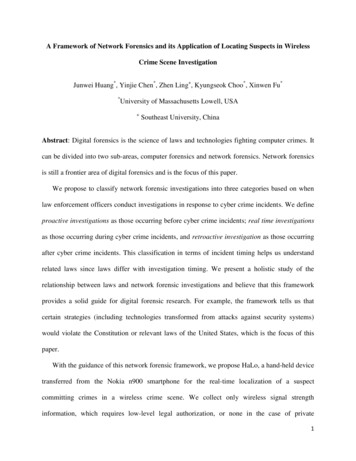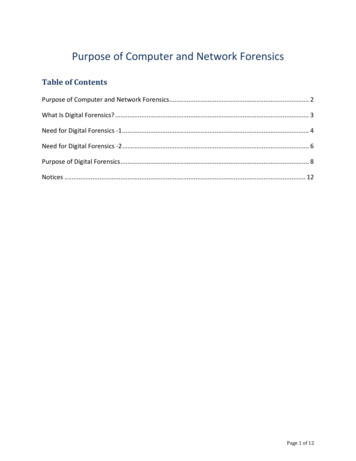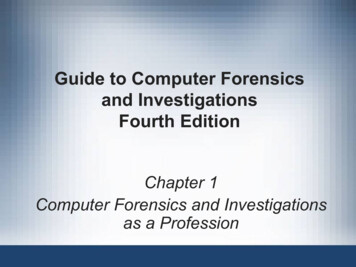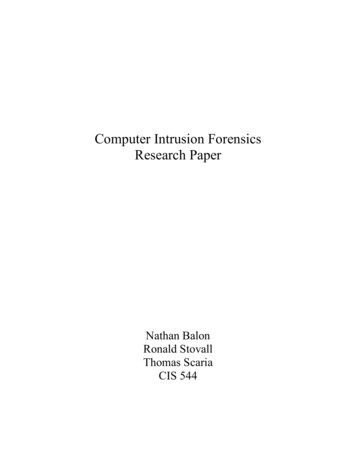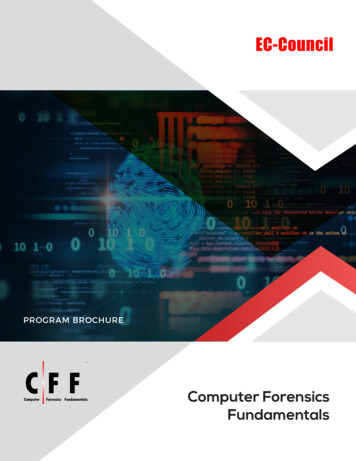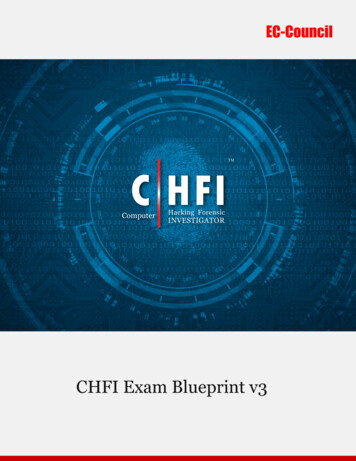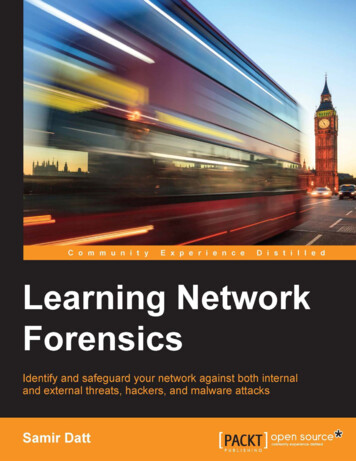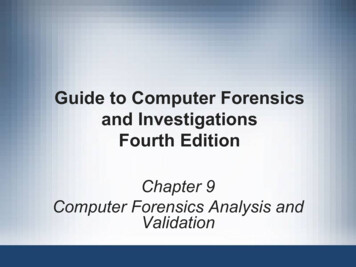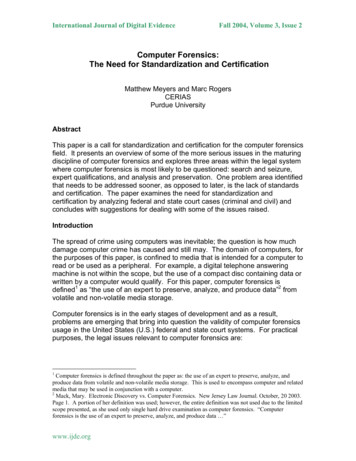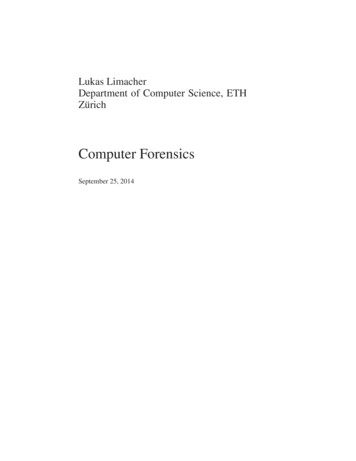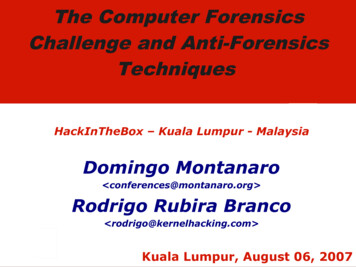
Transcription
The Computer ForensicsChallenge and Anti-ForensicsTechniquesHackInTheBox – Kuala Lumpur - MalaysiaDomingo Montanaro conferences@montanaro.org Rodrigo Rubira Branco rodrigo@kernelhacking.com Kuala Lumpur, August 06, 2007
AgendaDefeating forensics analysis Subverting clones/imaging processes Backdoors/Rootkits/Whatever Etc ;DData Remanence - Magnetic Media From erased data (covering some filesystems) From overwritten data From destroyed media
Being prepared to the incident Turn off or keep turned on the hw? It Depends RAM Clone ? Always Using the SO or hw specialized with DMA support? Take the HD out or clone? Clone Physical Manipulation of evidences? For Sure –Special equipment Hard Locks ? You kidding me, right?
MethodologyStraight Lines or curves?Method!
MethodologyForensics analysis require deep information technology knowledgeJust a few examples that can simply modify the “guilty-non guilty” boolean variable: ADS MD5 Simple image stego Slack Space Hiding data inside the "visible" filesystem Rootkits - Subverting the first step - Imaging
Aligning knowledge – the very beginningSimple file deletion on FAT filesystem
First StepFat entry deletedThis indicates that the areablocks occupied by that file arenow free
Second StepThe file’s registry on thedirectory’s entry is modifiedFirst char is changed(Ex: E5 Hex [Fat32])
Third Step? No! :(Data is still thereData blocks are still avaliable forrecovering until other aplication write inthe same clusters
How the recovery process worksIndex damaged and Directory entry ok - Easy recover by parsing directoryinformation and some items from the Index (example: format on Windowsmachines) – Remembering that NTFS stores a copy of it’s MFT in the middle of theunitNo Index and no Directory - Should be easy by header/footer search andgrabbing the middle contents, but some fragmentation issues could lead to get“currupted” files, which consist in “garbage” in the middle of a true “mailbox” file.Tool to perform recovery on header/footer (and also expected size) search:foremostOops: It’s almost impossible to see tools in the wild that perform structured fileanalysis, which are totally necessary to recover files by it’s internalscharacteristics (file format).For file formats, www.wotsit.orgFact: Only 1 kb of garbage in a contiguous file of 10MB can leadto non recovery of this file if no file format comparison is made
Magnetic LevelCertificaçãoDigitalCauses: Data overlapping:- Changing OS and FileSystem- Wipe tools
Magnetic LevelCertificaçãoDigitalMethod: STM (Scanning Tunneling Microscopy) SPM (Scanning Probe Microscopy) MFM (Magnetic Force Microscopy) - AFM (Atomic Force Microscopy)From: LFF – IF - USPWhy? HYSTERESISStudy: The Hysteresis Loop andMagnetic Properties
Magnetic LevelCertificaçãoDigitalFrom Iowa’s State University Center forNondestrutive Evaluation NDT (Non DestrutiveTesting)The loop is generated by measuring the magnetic flux of aferromagnetic material while the magnetizing force is changed. Aferromagnetic material that has never been previously magnetizedor has been thoroughly demagnetized will follow the dashed line asH is increased. As the line demonstrates, the greater the amount ofcurrent applied (H ), the stronger the magnetic field in thecomponent (B ). At point "a" almost all of the magnetic domainsare aligned and an additional increase in the magnetizing force willproduce very little increase in magnetic flux. The material hasreached the point of magnetic saturation. When H is reduced tozero, the curve will move from point "a" to point "b." At this point,it can be seen that some magnetic flux remains in the materialeven though the magnetizing force is zero. This is referred to as thepoint of retentivity on the graph and indicates the remanence orlevel of residual magnetism in the material. (Some of the magneticdomains remain aligned but some have lost their alignment.) As themagnetizing force is reversed, the curve moves to point "c", wherethe flux has been reduced to zero. This is called the point ofcoercivity on the curve. (The reversed magnetizing force has flippedenough of the domains so that the net flux within the material iszero.) The force required to remove the residual magnetism fromthe material is called the coercive force or coercivity of the material.As the magnetizing force is increased in the negative direction, thematerial will again become magnetically saturated but in theopposite direction (point "d"). Reducing H to zero brings the curveto point "e." It will have a level of residual magnetism equal to thatachieved in the other direction. Increasing H back in the positivedirection will return B to zero. Notice that the curve did not returnto the origin of the graph because some force is required to removethe residual magnetism. The curve will take a different path frompoint "f" back to the saturation point where it with complete theloop.
Magnetic LevelCertificaçãoDigitalIn other words:Hd’s Heads are onlyprepared to read and write 0or 1.When one bit is 0 and itchanges to 1, the head will“read/feel” 1 at the readtime, but what is stored inthe media is (for example)analogic 0,78 valueHD’s headswill read 0bit 1 originalChanged to 0Electronic Microscopes (such as confocalblue laser scaning) it is possible to noticeother “states” – rudimentar 0,12 forexample
Magnetic Level Possible because Information is digital, but it’s supporting technology is analogicPictures taken from methods in the previous slidesResiduals of overwritteninformation on the side ofmagnetic disk tracks.Reproduced with permissionof VEECO
Magnetic Level And How about 1-Step wipe? Good enough. Why?Simply to understand. Hard drives are coming with tons of storage space andit's “physical size” is always the same (most of the times same number ofplatters/heads then the previous model). The platters and heads are almostthe same scheme and the storage size is increasing each time more. So,various techniques to increase speed/storage capabilities imply on reducingdata recovering from electronic microscopy, such as Zoned Bit RecordingAs far as the track is from the center, itsupports more sectors, increasing thespace for storage but drastically reducingmagnetic data recoveryGraphic from PcGuide.com
Damaged Hard DrivesCertificaçãoDigitalCauses: Accidents- Accidental Falls- Destroying on purpose
Damaged Hard DrivesCertificaçãoDigitalMethod: Platters removal Special liquid for clearing the platters Low level reading of platters by genericsheads that have pre-configured vectors ofreading
False positive aboutDigitalDefectsCertificaçãoMost of data recovery softwares work trough BIOS(int 13h) or the OS to access disk clusters1 Cluster normally consists in 1 header, 512 bytes and ECCbyteWhen Recovery Software tries to get a cluster from the HD, if itcomes with a ECC bad checksum, it will assume that thisspecific cluster is a “bad cluster”One not-that-hard-to-code backdoor can simply forge this ECCbad checksum (error types “UNC” – Uncorrectable data - orAMNF – Address Mark Not Found) statically or dynamic tokeep it’s code on the media hard-to-find.So, to achieve reading of these sectors, some ATA commandsthat ignore ECC need to be issued to recover byte-a-byterather then sector-per-sector as most OS and BIOS do.
Acknowledges – The trip isfinishing :( Filipe Balestra and NicolasWaisman for helping in theImmunity Debugger Stuff HITB crew (mainly to XWings)for the nice time and patiencehere in Malaysia Your time in this talk!Expecting again a BrazilianWoman? Haha, gotcha! -
Thanks!Questions?Thank you :DRodrigo Rubira Branco rodrigo@kernelhacking.com Domingo Montanaro conferences@montanaro.org There's wherewe come from ;)
Slack SpaceNon-addressable space in the MFT than can be written by specfic tools (RAW) NTFS uses logical cluster of 4kb Files less than 4kb use 4kb (outside MFT) Tools can build a own MFT and address directlyon the disk its own blocks to use as a containerfor the backdoor (and can mark it as bad block tothe filesystem, so it would not be overwritten) Combining this to crypto/steganographic technicsshould make the forensics job much harder (andmost of times when it’s well done, efforts will belost)Update: Tool: Slacker from the Metasploit project
Slack Space
Slack Space- Hidden Data
Use of redundant/Zero/AlignspacesExecutables (ELF, Win32PE, etc) when compiled, depending on the compiler, most of thetimes need to have some space for alignment between soubroutines.Not a new idea in the IT field, since it's used by virii coders (injecting malware instructionsinto space used for 51A9:4AD051AA:C39090909055RETN ; end of subroutineNOP ;NOP ;Alignment that can be used to store dataNOP ;Can be 0x90, 0xCC or signature-based like GCCNOP ;PUSH EBP ; begin of next subroutine}On a 2GB “system” filesystem, it's possible to store nearly 1 MB on a “Second Filesystem”inside the “system” filesystem, only using alignment spaces (including DLLs) – Need toremember that relative (short) JMPs are needed to return in the program normal flow.
Going even deeperSo, every filetype has it's possibilities of storing “evil” data, not regardingcompression formats.Harmful to think on all this knowledge about hiding information (stego) in files tocome in a toolkit.Scenario:LibStego – Supports data hiding on several file formats, applying theparsing tons of these formats from wotsit.orgSupporting: 3 modes of operation1) Growing up files – Ex: comments on graphic files (as showedbefore)2) Use redundant space on Multimedia formats (GIF, JPEG, AVI,MOV, etc), OLE formats (doc, xls, ppt, etc – not talking aboutcompression here too) and others (DWG, CDR, etc)3) Use alignment space on executable files (PE, ELF, etc)
ADS – Alternate Data StreamsC:\ads echo "Conteudo Normal" teste.txtC:\ads echo "Conteudo Escondido" teste.txt:escondido.txtC:\ads dir /aPasta de C:\ads22/11/200422/11/200422/11/200400:59 DIR .00:59 DIR .00:5920 teste.txt1 arquivo(s)20 bytes2 pasta(s) 1.696.808.960 bytes disponíveisC:\ads type teste.txt"Conteudo Normal"C:\ads notepad teste.txt:escondido.txt
Hash Collisionblack@bishop: /quebra md5 ls1.asc 1.bin 2.asc 2.bin resultado.txtblack@bishop: /quebra md5 cmp 1.bin 2.bin1.bin 2.bin differ: char 20, line 1black@bishop: /quebra md5 md5sum 1.bin 2.bin79054025255fb1a26e4bc422aef54eb4 1.bin79054025255fb1a26e4bc422aef54eb4 2.bin
Hash collisionNot indicated to use only MD5 nowadaysFrom: Gerardo Richarte - CORE SDIMD5 to be considered harmful todaySame MD5Same CRC
Hash collisionAgain, not good to use only nfoo VERSION: Web Conflation Attack Using Colliding MD5 Vectors and JavascriptAuthor: Dan Kaminsky(dan\@doxpara.com)Example: ./confoo www.lockheedmartin.com active.boeing.com/sitemap.cfmAttack zStripwire emits two binary packages. They both contain an arbitrarypayload, but the payload is encrypted with AES. Only one of thepackages ("Fire") is decryptable and thus dangerous; the other ("Ice")shields its data behind AES. Both files share the same MD5 hash.
Simplistic Image SteganographyCertificaçãoDigital Image files follow their layout standards, as of anyother kind of file Each standard has it's own data hiding capabilities(GIF, BMP, TIFF, etc) – of course, not the originalpurposeEx: GIF89a Con: Not many tools to analyze file's layout,comparing it to a standard layout and a base oflayout possibilities (out-of-range values in somefields)And we are not even talking about the graphic part, which implies on techniques such asColor Reduction, LSB (Least Significant Bit) – noise, etc.
Dumbest stego method ;)Two simple filesSimply copy commandThe 2 files continue, but notice the size of“logo h2hc.gif”Opening the file on the standard Image Visualizationapp, it comes up what was expectedDragging and dropping the same GIF file on awinamp's window, we have 37 seconds of sound.
Userland protectionsWe enjoined this picture from Julie Tinnes presentationon Windows HIPS evaluation with Slipfest
After kernel compromise, life isnever the sameThere are many techniques in the wild to subvert forensics analisysIn ring0 fights, it's all a mess. - Let's protect the ring0!First thing the we should do to analyze a compromised machine is to clonethe RAM contents. Why? Because all binaries in the system can be cheatedstatically (binary itself modified) or dynamically (hooked in int80h).So, what do we find in the RAM analysis? *Should be* EverythingStructures commonly searched in memoryEPROCESS and ETHREAD blocks (with references to the memory pages used by theprocess/threads)Lists like PsActiveProcessList and waiting threads to be scheduled (used for crossview detection)Interfaces(Ex: Ethernet IP, MAC addr, GW, DNS servers)Sockets and other objects used by running processes (with detailed informationregarding endpoints, proto, etc)
Grabbing RAM contentsRAM cloneWindowsE:\bin\UnicodeRelease .\dd.exe if \\.\PhysicalMemoryof E:\Ram Clone.bin bs 512 conv noerrorLinuxking:/mnt/sda1# ./dcfldd if /dev/mem of Ram Clone.bin bs 512conv noerrorTrustable Method?
Windows MalwarePiece of cake: Malware running in user-space(99% of trojan horses that attack brazilian users in Scam)
Windows MalwareInject kernel modules to hide themselvesExamples: Hacker Defender Suckit Adore Shadow WalkerThese rootkits use well known techniques (Ex: IAT hooking) to monitor/subvert userspace/kernel-space conversations.Kernel-SpaceKernelWhich File? \\.\PhysicalMemory \\.\PhysicalDrive0dd.exeUser-SpaceReadFile()Etc.
RAM Forensics – Linux ScenarioOn Linux, to proceed with RAM analysis, tools like Fatkit are used (Static memorydump file analysis)But at clone time, the destination image can be subverted if the machine iscompromised with a custom rootkitKernel-SpaceKernelint0x80dcflddUser-SpaceIs it requesting the addrsof the backdoortask struct?Yes? So send httpdtask structexecve - /bin/dcflddopen - /etc/ld.so.cacheread - /bin/dcfldd (ELF)mmap2,fstat and others
RAM Forensicsssize t h read(int fd, void *buf, size t count){unsigned int i;ssize t ret;char *tmp;pid t pid;If the fd (file descriptor) contains somethingthat we are looking for (kmem or mem)return address();At this point we could check the offset beingrequired. If is our backdoor addr, sendanother task structret o read(fd,buf,count);change address();return ret;}int return address(){return our hacks to theoriginal state}int change address(){put our hacks intothe kernel}
Windows MalwareLet's say our scanner/detector/memory dumper/whatever resides in Kernel-Spaceand althout using ReadFile() uses ZwReadFile or ZwOpenKey or Zw***.Reliable? SST – System Service Table HookingC:\ SDTrestore.exeSDTrestore Version 0.2 Proof-of-Concept by SIG 2 G-TEC B80KeServiceDecriptorTable.ServiceTable 804E2D20KeServiceDescriptorTable.ServiceLimit 284ZwClose19 --[hooked by unknown at FA881498]-ZwCreateFile25 --[hooked by unknown at FA881E16]-ZwCreateKey29 --[hooked by unknown at FA882266]-ZwCreateThread35 --[hooked by unknown at FA880F8E]-ZwEnumerateKey47 --[hooked by unknown at FA882360]-ZwEnumerateValueKey49 --[hooked by unknown at FA881EDE]-ZwOpenFile74 --[hooked by unknown at FA881D6C]-ZwOpenKey77 --[hooked by unknown at FA8822E2]-ZwQueryDirectoryFile91 --[hooked by unknown at FA881924]-ZwQuerySystemInformation AD --[hooked by unknown at FA881A4A]-ZwReadFileB7 --[hooked by unknown at FA8810EE]-ZwRequestWaitReplyPortC8 --[hooked by unknown at FA881310]-ZwSecureConnectPortD2 --[hooked by unknown at FA8813EA]-ZwWriteFile112 --[hooked by unknown at FA881146]-Number of Service Table entries hooked 14
Windows MalwareOk, let's say we want to go deeper and graba file directly from the HD: Then we useIoCallDriver() to talk directly with theHDD.Readfile()(Win32 API)ApplicationNtReadfile()(Kernel 32.dll)Int 2E(Ntdll.dll)User ModeKernel ModeKiSystemService(Ntoskrnl.exe)Reliable?Call NtReadFile()(Ntoskrnl.exe)Initiate I/O Operation(driver.sys)File System Driver(ntfs.sys, ) IRP ( I/O Request Packet) HookingVolume manager disk driver(ftdisk.sys, dmio.sys)Disk Driver (disk.sys)I/O ManagerDisk port driver (atapi.sys, scsiport.sys)Disk miniport driver123Disk ArrayFonte: Rootkits – Advanced MalwareDarren Bilby
Keep it simple!How about if our memory grabber just sets up a pointer to offset 0x00 of RAMmemory and copies to another var till it reaches the end of memory? (Regardlessof race conditions to kernel memory)Reliable?WatchPoints in memory pages (DR0 to DR3)When our backdoor offset is hitby the “inspector” it will generatea #DB (Debug Exception) which wecan work on it
Securely? Grabbing the RAM contentsSome hardwares attempt to get the RAM contentsThese type of solutions rely on the DMA method of accessing the RAM andthen acting on it (CoPolit) or dumping it (Tribble) Tribble – Takes a snapshot (dump) of the RAMhttp://www.digital-evidence.org CoPilot – Audits the system integrity by looking at the RAM Contentswww.komoku.com/pubs/USENIX-copilot.pdf Other Firewire (IEEE 1394) Methods – Michael Becher, MaximillianDornseif, Christian N. Klein @ Core05 CanSecWestReliable method?Joanna Rutkowska showed on BlackHat DC 2007 a technic using MMIO thatcould lead the attacker to block and trick a DMA access from a PCI card.
The Kernel War As Montanaro showed until now in thepresentation, if the attacker compromised themachine and have access to the kernel, a lot ofproblems will appear:– We can signature detect the forensics tool: Multiple (continuous) memory reads Multiple (continuous) disk reads– Even deeper: Binary program signature (like antiviruses use todetect a virus) Program behaviour (what the program does? howthey does that?)
Looking for patterns We have used the excelent Immunity Debugger with a simple pythonscript to search a binary file for patterns:allmodules imm.getAllModules()for key in allmodules.keys():imm.Log("Found module: %s" %key)usekey ""for key in allmodules.keys():if key.count(".exe"):imm.Log("Found executable to dump %s" %key)usekey keybreakmodule to dump allmodules[key]base module to dump.getCodebase()size module to dump.getCodesize()codememory imm.readMemory(base,size)hex codememory codememory.encode('hex-codec') Here you put your magic ;) like if you want to recognize sequences of bytes, strings unmodified between versions, etc
Looking for patterns
Looking for patterns The program behaviour is a really easy way toidentify a forensic tool:– Regular reads to some directories (like configurationfiles, libraries and others)– Start read position in a memory dump (some systemsfirst try to discover a backdoor manipulating the system,opening the memory devices, some others just try toload a kernel module to verify kernel violations, etc)
Detecting forensics tool We can hook system loading interfaces to easilyspot a new program been runned, and themanalyse the program and compare to a signaturebase:– ld.so, init module, lsm, load binary, do execve, do fork,. But, how about other tools?
Fighting against Forensics tools – Theold school A lot of different talks about different ways to hideinformation from a Forensics tool – our approach is notto try to hide it, but discover a forensic tool running inthe system (if someone is analysing the system, isbecause they already know something is wrong)
Old school quick tour Shadow Walker talk at Blackhat by Sherri Sparksand Jamie Butler showed the idea of use TLBdesyncronization to hide your rootkit Basicly it uses:– Page fault handling patches– Pages are marked as non-present, and the page-faultsystem will verify if the instruction pointer is pointing tothe faulted address (cr2) to differentiate between aread/write and one execution– The page fault system marks this pages as non-pageableto differentiate between 'protected' pages and thecommon ones (in Linux if you are just using kernelpages don't need to care about that)
Old school quick tour There are a lot of problems with this approachagainst a Forensic analyst (skilled one) – asspotted by the authors of this idea:– It's easy to detect IDT modifications and for sure tocheck the page faulting mechanics– Non present pages in non paged memory range arereally not normal
Old school quick tour Another approach is to hide your patches to the kernelusing the debugger registers (we covered a lot abouthow to do that in our presentation about kernel integrityprotection in the VNSecurity Conference) The problem is it can also be verified just using thesegmentation support existent in the platform tobypass breakpoint hit or (also easy) just patching thedebugging interrupt handling by yourself and trying tomodify the debug registers (it will generate andexception if someone have set the general detectionflag in dr7)
Anti-forensics hide rootkit If you need to use disk (to transfer things to themachine and don't want to use syscall proxying-likesystems) you can do that in many different ways(pointed by Montanaro) and also:– Transfer your data to system memory– Force it to be loaded in a high virtual memory, and causes apage-out of this data (you also need to patch the pagingsystem)– If it is a big machine you can use kmap to remap youraddresses from ZONE HIGH to ZONE NORMAL when youneed to manipulate it (read/write)– A simple crypting routine using a session key is enough (doyou remember we are protecting the system against a memorydump) – We don't care about rootkit detection itself
What is needed in an anti-forensicrootkit? It must detect a forensic analysis and react to it(maybe removing all the evidences, including itself) In some way it must be 'pattern free', so it cannot bedetected by common ways (to detect it will be neededa lot of knowledge from the analyst, and it is almostimpossible to detect if you don't know the rootkit itself) Maybe the Virtualized Rootkit is dead, but what aboutuse another hardware resource in rootkits?
How? SMM!SMM – System Management ModeThe Intel System Management Mode (SMM) is typicallyused to execute specific routines for powermanagement. After entering SMM, various parts of asystem can be shut down or disabled to minimize powerconsumption. SMM operates independently of othersystem software, and can be used for other purposestoo.From the Intel386tm Product Overview – intel.com
SMM and Anti-Forensics?
SMM and Anti-Forensics? Duflot paper released a way to turn off BSD protections using SMM A better approach can be done using SMM, just changing the privilege levelof a common task to RING 0 The segment-descriptor cache registers are stored in reserved fields of thesaved state map and can be manipulated inside the SMM handler We can just change the saved EIP to point to our task and also the privilegelevel, forcing the system to return to our task, with full memory access Since the SMRAM is protected by the hardware itself, it is really difficult todetect this kind of rootkit
Descriptor Cache From the Intel Manual: “Every segment register has a “visible”part and a “hidden” part. (The hidden part is sometimes referredto as a “descriptor cache” or a “shadow register.”) When asegment selector is loaded into the visible part of a segmentregister, the processor also loads the hidden part of the segmentregister with the base address, segment limit, and accesscontrol information from the segment descriptor pointed to bythe segment selector. “ RPL – Request Privilege Level CPL – Current Privilege Level DPL – Descriptor Privilege Level
Descriptor Cache In the saved state map (inside SMM): TSS Descriptor Cache (12-bytes) - Offset: 7FA4 IDT Descriptor Cache (12-bytes)- Offset: 7F98 GDT Descriptor Cache (12-bytes) - Offset: 7F8C LDT Descriptor Cache (12-bytes) - Offset: 7F80 GS Descriptor Cache (12-bytes)- Offset: 7F74 FS Descriptor Cache (12-bytes)- Offset: 7F68 DS Descriptor Cache (12-bytes)- Offset: 7F5C SS Descriptor Cache (12-bytes)- Offset: 7F50 CS Descriptor Cache (12-bytes)- Offset: 7F44 ES Descriptor Cache (12-bytes)- Offset: 7F38
SMM Relocation SMM has the ability to relocate its protected memory space.The SMBASE slot in the state save map may be modified.This value is read during the RSM instruction. When SMM isnext entered, the SMRAM is located at this new address - inthe saved state map offset 7EF8– Some problems to perform CS adjustments It can be used to avoid SMM memory dumping for analysis
Generating #SMI's We explained really deeply why the system will generate#SMI in Xcon this year Now, we can just instrument our kernel (in any portion of it, soturning really difficult to detect) an I/O operation to a sharedaddress between devices (as Duflot spotted in his paper,0xA0000h) sounds good This idea can be used together with a BIOS rootkit, toconfigure an SMI handler, lock the SMM (relocating theSMRAM) and then transfering control back to normal bootsystem – if someday the system triggers a SMI, it will installthe backdoor, bypassing all kind of boot protections
Forensics analysis require deep information technology knowledge Just a few examples that can simply modify the "guilty-non guilty" boolean variable: ADS MD5 Simple image stego Slack Space Hiding data inside the "visible" filesystem Rootkits - Subverting the first step - Imaging Methodology


